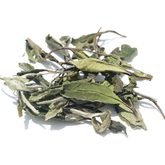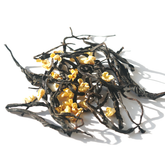Jasmine Green Tea Benefits And A Complete Introduction
Chinese Jasmine tea is renowned for its delightful fragrance! As a tea sourcing manager in China, I highly recommend this tea for beginners. If you’re new to tea, the sweet floral aroma combined with green tea’s refreshing taste will surely captivate you. High-quality jasmine tea offers a pleasant floral scent and a mild sweetness, making it a favorite among newcomers, especially those who don’t like bitterness.
As a procurement manager with over 10 years of experience in tea sourcing from a Chinese tea company, I’ve found that most of the information online about Chinese jasmine tea is inaccurate. In this blog, I will provide all the essential details you need to know about Chinese jasmine tea and its health benefits.
Recommended purchase:
Where Does Jasmine Green Tea Come From?
The core producing area of jasmine tea is Hengxian County in Guangxi Province, southern China. Hengxian produces about 60% of the world’s fresh jasmine flowers and over 80% of China’s supply, earning it the title of “World Capital of Jasmine.” The county’s warm, humid climate, abundant sunlight, and fertile soil make it ideal for jasmine cultivation, resulting in flowers with a rich and lasting fragrance.

Jasmine tea is made from two main ingredients: fresh jasmine flowers and green tea. The green tea comes from many regions across China. After being produced locally, it is transported to Hengxian, where more than 150 processing factories carry out the traditional scenting process to create jasmine green tea.
History of Jasmine Flower Tea
Origin: Jasmine tea dates back to China’s Han dynasty (206 BCE – 220 CE), but the form we know today was developed during the Song dynasty (960 CE – 1279 CE). The method of blending tea with jasmine flowers, known as “scenting,” became the foundation of jasmine tea production. By the Ming and Qing dynasties (1368 CE – 1912 CE), the technique was perfected.
Spread: Fuzhou in Fujian Province is the primary source of jasmine tea. In the late Qing dynasty (19th century), jasmine tea began to be exported, becoming popular internationally, especially with Empress Dowager Cixi’s fondness for it.
Decline and Revival: During the late Qing and early Republic period (19th to early 20th century), the industry declined due to turmoil. After the founding of the People's Republic of China (1949), jasmine tea experienced a revival, with Fuzhou and Hengxian in Guangxi province becoming global production hubs.

Jasmine Tea Production Process
Basic Introduction to the Craft of Jasmine Tea
Jasmine tea is a type of tea that is made by blending the fragrance of fresh jasmine flowers with tea leaves through a special process. The production process typically involves several rounds of scenting (where fresh jasmine flowers are mixed with tea), during which the tea leaves absorb the fragrance of the flowers, resulting in the unique, delicate aroma of jasmine tea.
The crafting of jasmine tea is not only a technique but also an art, requiring the tea master to have precise control over temperature, humidity, and time, as well as a perfect balance of the ratio between the tea and the flowers.

Combining Tea Leaves with Jasmine Flowers
Jasmine tea is typically made using green tea as the base. After being harvested and initially processed, green tea retains many of its natural components and refreshing flavor. Manufacturers stack fresh jasmine flowers and green tea leaves in layers and use the scenting process to allow the tea leaves to absorb the floral fragrance.
Each round of scenting enables the tea to absorb more of the jasmine aroma, gradually blending the fragrance with the natural taste of the tea. This process usually requires several rounds to ensure the tea leaves fully absorb the jasmine scent.

Emphasizing Natural Aroma
Unlike many Western tea products, the fragrance of jasmine tea comes entirely from natural jasmine flowers, without the use of artificial fragrances or chemical additives. This makes jasmine tea not only pure in taste but also healthier.
Traditional jasmine tea is made without any artificial additives during the production process, which is one of the reasons it is so popular among tea lovers around the world.
Why Green Tea is Used as the Base for Jasmine Tea
Green tea is often chosen as the base for jasmine tea because of its natural freshness and relatively low bitterness, which allows it to perfectly blend with the floral aroma of jasmine. Green tea has a refreshing taste and retains more natural components like tea polyphenols, which provides a more balanced and rich flavor profile for jasmine tea.
Most importantly, after years of refinement, green tea has been found to be the best at absorbing the jasmine fragrance, and it also retains the aroma better than other types of tea.
How To Choose Good Quality Jasmine Tea?
About the Scenting Process of Jasmine Tea
"Scenting" refers to the process in which jasmine flowers come into contact with the tea leaves. Each time the tea is scented, it absorbs more jasmine fragrance. Generally, the more times the tea is scented, the stronger its aroma becomes.
However, it’s important to note that the number of scenting cycles labeled by manufacturers may not always be entirely accurate, as some low-quality teas may artificially enhance the fragrance or add synthetic scents. Therefore, when purchasing jasmine tea, it's best to choose reputable brands rather than solely focusing on the number of scenting cycles.
Pay Attention to Expiry Date
The fragrance of jasmine tea fades over time, so it is important to pay attention to the tea’s expiry date when choosing it.
Jasmine tea is best consumed within six months of production, as the aroma decreases significantly and the taste can be affected after it expires. Try to choose freshly produced tea and consume it as soon as possible after purchase, ensuring it is sealed properly to prevent the loss of fragrance.
Green Tea Base Retains Aroma Longer
Green tea is commonly used as the base for jasmine tea because the jasmine fragrance blends effectively with the green tea's natural aroma and remains longer. Compared to lower-quality black tea or other bases, green tea does a better job of preserving the natural jasmine fragrance.
Therefore, choosing jasmine tea with a green tea base will result in a more long-lasting aroma.
The Better the Aroma, the Higher the Price
High-quality jasmine tea usually uses premium green tea as the base, often sourced from top tea gardens where the leaves are whole and tender. This is inherently more expensive. Additionally, the production process requires a large amount of fresh jasmine petals, which incurs significant costs.
Each scenting cycle also involves considerable labor costs. As a result, jasmine tea with a stronger fragrance is more costly.(Shop NPTEA's Jasmine Tea Collections)
Health Benefits of Jasmine Green Tea
Antioxidant Effects
Jasmine green tea is rich in natural antioxidants, such as tea polyphenols, particularly catechins found in the base of green tea. These compounds have been proven to possess significant antioxidant properties, helping neutralize free radicals and slow down the aging process. According to a study in the Journal of Food Science, catechins in green tea have powerful antioxidant effects and may reduce the risk of chronic diseases.
Promoting Heart Health
The polyphenolic compounds in tea help lower cholesterol levels and improve blood lipids, thereby reducing the risk of heart disease. A study published in the American Journal of Clinical Nutrition found that natural compounds in green tea can effectively lower low-density lipoprotein (LDL) cholesterol levels, promoting cardiovascular health.
Improving the Digestive System
The natural aroma and chemical components of jasmine tea can help alleviate indigestion, promote gastrointestinal motility, and relieve discomfort. A study in the Phytomedicine journal suggested that components in green tea have a beneficial effect on the gastrointestinal system, aiding digestion and reducing stomach pressure.
Relieving Stress and Anxiety
The scent of jasmine tea is believed to have calming and relaxing effects. Studies show that the aroma of jasmine can help reduce stress and anxiety, promoting emotional stability. Research published in Obesity Reviews indicates that the fragrance of tea and its gentle components have a calming effect on the nervous system, helping to alleviate psychological stress.
Boosting Immunity
The antioxidants and natural components in jasmine tea can enhance the function of the immune system, helping to ward off common illnesses. A study in The Journal of Nutritional Biochemistry showed that tea polyphenols enhance immunity and can effectively fight off bacteria and viruses.
Helping with Weight Loss
Jasmine tea aids in accelerating metabolism and promoting fat burning, which can help with weight loss. A study in Phytotherapy Research found that components of green tea assist in weight reduction by increasing the basal metabolic rate. As a variant of green tea, jasmine tea has similar effects.
Does Jasmine Green Tea Contain Caffeine?
The primary ingredient in jasmine tea is green tea, which is one of the six major types of tea. Therefore, jasmine tea also contains caffeine. However, the effect of caffeine in tea is milder compared to coffee and doesn't have an immediate stimulating effect. For those looking to reduce caffeine intake, tea is a better alternative to coffee.

The caffeine content in jasmine tea is typically around 20-30 milligrams per cup, much lower than the over 100 milligrams found in a cup of coffee. If the tea is brewed at a lower concentration, the caffeine content can be further reduced, making it a much gentler option than coffee. If you are particularly concerned about the effects of caffeine, you can opt for cold-brew jasmine tea. Not only does it have a very charming flavor, but the caffeine content is also significantly lower.
Who Should Drink Jasmine Tea?
Women: With its smooth, mild flavor, jasmine tea is especially popular among women who prefer less bitterness in their tea.
Tea Lovers Who Enjoy Floral Aromas: The natural jasmine fragrance makes it a go-to choice for many who appreciate subtle, aromatic teas.
Tea Beginners: Easy to brew, jasmine tea is a great entry point for newcomers to tea culture.
How to Brew Jasmine Tea
Daily Method : Transparent Glass Cup
Temperature: Brew at 80-85°C to preserve the delicate fragrance and avoid bitterness.
Quantity: Use 3-5 grams of tea per cup, depending on your teapot size.
Steeping Time: Steep for 1-2 minutes for a light, clear brew. For a stronger flavor, extend the steeping time but avoid exceeding 3 minutes.

Gongfu Method :Porcelain Gaiwan (120ml-150ml)
Temperature: 80°C–85°C. Avoid boiling water to prevent scalding the tea leaves and destroying the floral aroma.
Tea-to-Water Ratio: Recommended 1:50 (e.g., 5g of tea with 250ml of water).
Steeping Time: First infusion about 10–15 seconds; for subsequent infusions, increase by 5–10 seconds each time to maintain a fresh, fragrant tea.

Final Thoughts on Jasmine Green Tea
Jasmine tea originated in China and has become a popular choice among tea lovers worldwide due to its long development in craftsmanship. By combining fresh jasmine flowers with green tea, the tea absorbs the floral fragrance, creating a unique flavor. The aroma of jasmine tea is natural and free from additives, offering numerous health benefits such as antioxidants, promoting heart health, and relieving stress.
When choosing high-quality jasmine tea, it's important to pay attention to its shelf life, as the fragrance of jasmine can dissipate over time. Jasmine tea is especially suitable for women because its brewing method is simple and does not require complex tea ware.
SEE MORE ABOUT TEA
If you are a beginner about Chinese tea:
Basic-Guide-to-Chinese-Tea
If you have questions about selecting tea:
Learn-more-about-chinese-tea
If you have questions about the benefits of tea:
Health-benefits-of-chinese-tea
If you have questions about brewing tea:
How-to-brew-loose-leaf-tea









